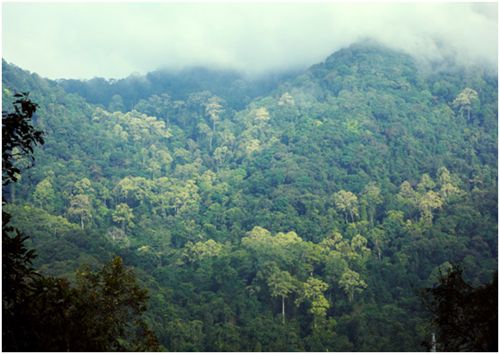Ecology:中科院版纳植物园等解析热带森林群落构建的多重生态过
Ecology 在线发表中国科学院西双版纳热带植物园与加利福尼亚大学洛杉矶分校的学者合作解析热带森林群落构建的多重生态过程,研究题为“Drought tolerance as a driver of tropical forest asseMBLy: resolving spatial sigNatures for multiple processes” 。
性状在空间上的变化格局可以反映驱动群落构建的生态过程,这可以用来检验关于性状与环境是如何驱动这些生态过程的假说。中国科学院西双版纳热带植物园的科技人员与加利福尼亚大学洛杉矶分校的学者合作,在西双版纳20-ha热带季节雨林动态样地,定量测定了43个共存树种耐旱性方面的性状、其他生理性状和通用性状,比较了其在解析生境关联、基于生态位重叠的竞争和等级竞争这三个群落构建的生态过程时的能力。
该研究应用wavelet分析方法在排除大尺度的生境关联的效应后定量化评价0-20m邻体尺度上的竞争作用。树种的干旱耐受性与反映土壤水分供应的生境变量是树种生境关联的强驱动力,并且干旱耐受性反映出显著的影响竞争作用的空间信号。总体来看,多元模型的定量结果显示,与生境最相关的性状为叶片密度,叶片膨压丧失点(叶片耐失水能力)和茎干导水性。在邻体尺度上,物种间的空间关联与物种间的叶片耐失水能力的相似性呈正相关关系,这与等级竞争的预测结果相符。虽然叶片耐失水能力与种间空间关联的关系较弱,但仍然反映了耐旱性对邻体相互作用与群落构建的持续影响效应。定量化性状对竞争作用的效应需要进一步整合种内个体间的性状可塑性,特别是不同生活史间的性状变异,并从单一性状扩展到多重性状对植物整体表现与资源需求的作用上来。

西双版纳20-ha热带季节雨林动态样地鸟瞰图
原文链接:
Drought tolerance as a driver of tropical forest assembly: resolving spatial signatures for multiple processes
原文摘要:
Spatial patterns in trait variation reflect underlying community assembly processes, allowing us to test hypotheses about their trait and environmental drivers by identifying the strongest correlates of characteristic spatial patterns. For 43 evergreen tree species (> 1cm dbh) in a 20 ha seasonal tropical rainforest plot in Xishuangbanna, China, we compared the ability of drought tolerance traits, other physiological traits and commonly measured functional traits to predict the spatial patterns expected from the assembly processes of habitat associations, niche overlap-based competition, and hierarchical competition. We distinguished the neighborhood-scale (0- 20m) patterns expected from competition from larger-scale habitat associations with a wavelet method. Species' drought tolerance and habitat variables related to soil water supply were strong drivers of habitat associations, and drought tolerance showed a significant spatial signal for influencing competition. Overall, the traits most strongly associated with habitat, as quantified using multivariate models, were leaf density, leaf turgor loss point (πtlp; also known as the leaf wilting point), and stem hydraulic conductivity (r2 range for the best fit models = 0.27-0.36). At neighborhood scales, species spatial associations were positively correlated with similarity in πtlp, consistent with predictions for hierarchical competition. Although the correlation between πtlp and interspecific spatial associations was weak (r2 < 0.01), this showed a persistent influence of drought tolerance on neighborhood interactions and community assembly. Quantifying the full impact of traits on competitive interactions in forests may require incorporating plasticity among individuals within species, especially among specific life stages, and moving beyond individual traits to integrate the impact of multiple traits on whole-plant performance and resource demand.
http://dx.doi.org/10.1890/15-0468.1
作者:Megan Kathleen Bartl

